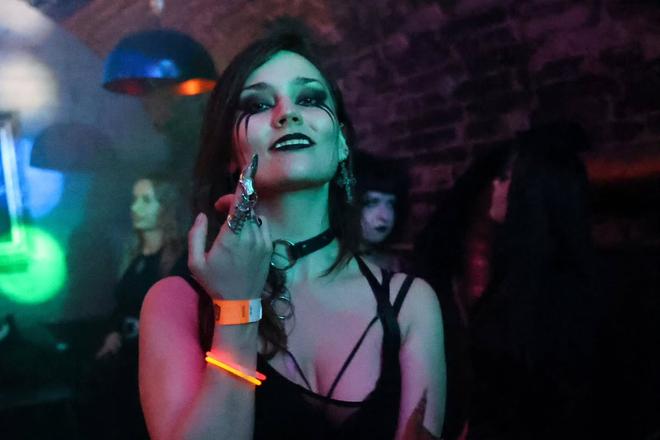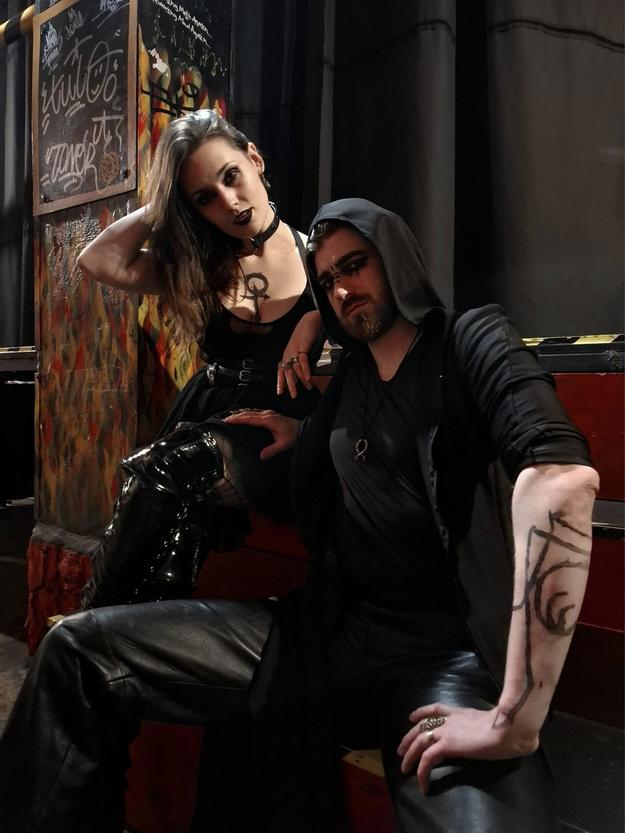Deep beneath bars you’ve never heard of, people gather to play games you’d never understand, dressed in outfits you wouldn’t be caught (un)dead in. This is the World of Darkness – a realm ruled by vampires. With the second edition of Rave of Caine looming, garlic is packed, a crucifix gripped tight – and the descent into the crypt begins.
This is no mere costume party. It’s live-action roleplaying — or LARP — a form of collaborative storytelling, part improvised theatre, where players embody characters in a shared fictional world. At the heart of Slovakia’s scene is “Vampire: The Masquerade”, a 1991 American game where players take on the roles of vampires and their servants, navigating a shadowy society of clans, politics and existential dread.
RAVE OF CAINE VOL. 2
When: Saturday, 10 May 2025
Where: FUGA, Bratislava
Time: 19:00 – 03:00
Entry: €8 advance / €10 at the door
In Slovakia, this niche subculture thrives, blending gothic fantasy, local myth and, more recently, techno raves.
The bloody saga began in August 2023, when Šimon “Dogyno” Kravár, from Nitra, and Richard Valuch, from Bratislava, connected on a Slovak Discord server for live-action roleplayers. Valuch had floated a small idea: a vampire game for 10 people. “My friend Dogyno, who got me into role-playing, said we should make it happen,” he recalls. What began as a pandemic-era distraction from boredom – and too much League of Legends – evolved into “Nitra by Night”: an atmospheric vampire LARP that now anchors Slovakia’s underground gothic scene.
For Kravár, it was deeply personal. Having returned to Nitra with his wife and child, he saw she was struggling with the upheaval. To ease the transition, he reignited their shared passion for immersive vampire storytelling, first sparked during their years in Warsaw. “We needed something to do,” he says. The game became a creative lifeline.
Slovakia, with its evocative Central European gothic energy, is fertile ground for vampire mythology. Countess Elisabeth Báthory, the infamous noblewoman said to bathe in blood, haunts local legend, as does Orava Castle – the filming site of “Nosferatu” in 1922. “The Carpathian Mountains are a vampire country,” says Valuch, tying Slovakia’s myths to the game’s enduring appeal. Even Bram Stoker’s “Dracula” mentions the word “Slovak” 21 times, portraying Slovaks – along with Romani – as the Count’s trusted assistants.
Bram Stoker, Dracula (1897)
“The strangest figures we saw were the Slovaks, who were more barbarian than the rest, with their big cow-boy hats... on the stage they would be set down at once as some old Oriental band of brigands... rather wanting in natural self-assertion.”
From diplomatic panic to dapper vampire
Player Matej Peniaško was roped into “Nitra by Night” — a live-action Vampire: The Masquerade game held in the city of Nitra — by Valuch. Thrust into the role of Keeper of Elysium, a kind of vampire diplomat responsible for maintaining peace among the undead, he was daunted. “I was still learning the lore, the clans, the rules,” he admits. “It was intimidating.” With some improvisation and support from the community, he settled into the role. While he describes himself as a “lazy player”, still shaky on the game’s intricacies, the community’s forgiving nature made room for that. His first character – a Tremere, one of the game’s secretive, mystical clans – was, in his words, “the least Tremere you could find under the moon”.
His partner and player, Roxana Rajtaková, a goth who stumbled into “Nitra by Night” with no prior knowledge of the game, was instantly drawn in. “My little goth heart just said yes,” she says. She fell for the Toreador – a vampire clan obsessed with beauty and art – and crafts characters in regal Victorian outfits, hiding monstrous hearts beneath lace. “Vampires are a paradox,” she muses, “dark and forbidden, yet alluring through their power.” Her favourite fictional vampire is Gary Oldman’s Dracula – elegant, stately and austere – but also capable of great violence.
Vampire mastermind Šimon Kravár brings scholarly zeal to his roleplay. Hooked since his first Brujah character – a clan known for passion and rebellion – met a tragic end (staked and left for sunrise), he now favours the Tremere, whom he calls “what happens to overly ambitious seekers of knowledge”. His encyclopaedic rants about the game’s eighteen playable options, including Ghouls (humans who serve vampires in exchange for blood) and Thin-Bloods (weak, diluted vampires), are both impressive and faintly ridiculous. Together, they paint a scene where enthusiasm trumps perfection, and costumes – Peniaško’s dapper Tremere, Rajtaková’s Victorian gowns – reflect the players’ quirks as much as their characters.
Rave of Caine opens a portal to a blood-soaked parallel world
In Bratislava, the scene expanded with “Rave of Caine”, a chaotic event blending LARPers (Live Action Role Players), goths, and techno into a vampire-themed party inspired by the “Vampire: The Masquerade” mythos. Rajtaková praises its “experimental nature”, merging subcultures into “a very exciting event”. Kravár sees it as a gateway, opening the game’s dark fantasy to new players. Peniaško calls it a “parallel universe spin-off”, a low-stakes romp where players can go wild without derailing “Nitra by Night”, a long-running Slovak LARP campaign. “It’s a teaser for people who know nothing about LARP,” he says, ever the pragmatist.
Valuch, however, found it stressful. “I kept worrying whether everything would go according to plan,” he admits, his pride tinged with exhaustion. One can’t help but chuckle at the image of a man fretting over a fake vampire rave’s logistics, but his dedication shines. “Rave of Caine” reflects the game’s broader appeal: a mix of gothic romance and modern grit, drawing from 1980s counterculture and stylised films like “Blade” and “The Crow”, as Valuch notes. It’s a bold step for a small scene, even if its rough edges need polishing.
Why it bites
At its core, “Vampire: The Masquerade” is about humanity’s shadows. “It explores human weaknesses through monstrous characters,” Rajtaková says, noting its intense, enlightening stories. The organiser agrees, citing themes like capitalism, surveillance and extremism that resonate today. The community is the glue holding the whole scene together. “It’s great and accepting,” Peniaško says, who credits it for making his bumpy entry into the LARP world possible.
For Valuch, storytelling became a way to process difficult personal experiences. For Rajtaková, the scene became a sanctuary for her gothic sensibilities. For Kravár, it’s about building layered narratives in a mythos that resonates with Slovak cultural history. Local vampire legends lend the game additional authenticity, grounding the fantasy in a familiar and eerie landscape.
Slovakia’s vampire LARPers occupy a space somewhere between performance art and personal exploration. From “Nitra by Night”’s humble origins to the sensory overload of “Rave of Caine”, this is a subculture that thrives on creative risk and emotional investment. It’s easy to scoff at grown adults pretending to be undead aristocrats – but for those involved, it’s a space to connect, to imagine and, in some cases, to heal.
Next time you’re in Slovakia, you might stumble into a LARP night. Just don’t expect to grasp every rule. As Peniaško might put it: improv, enthusiasm and a good coat will get you surprisingly far.


 Vampire Roxana lets down her fangs. (source: Anang Dadich)
Vampire Roxana lets down her fangs. (source: Anang Dadich)
 A view of Nitra from one of the seven hills that the city is built on. (source: Tourist Information Centre Nitra)
A view of Nitra from one of the seven hills that the city is built on. (source: Tourist Information Centre Nitra)
 Matej Peniaško and Roxana Rajtaková (source: Rave of Caine)
Matej Peniaško and Roxana Rajtaková (source: Rave of Caine)